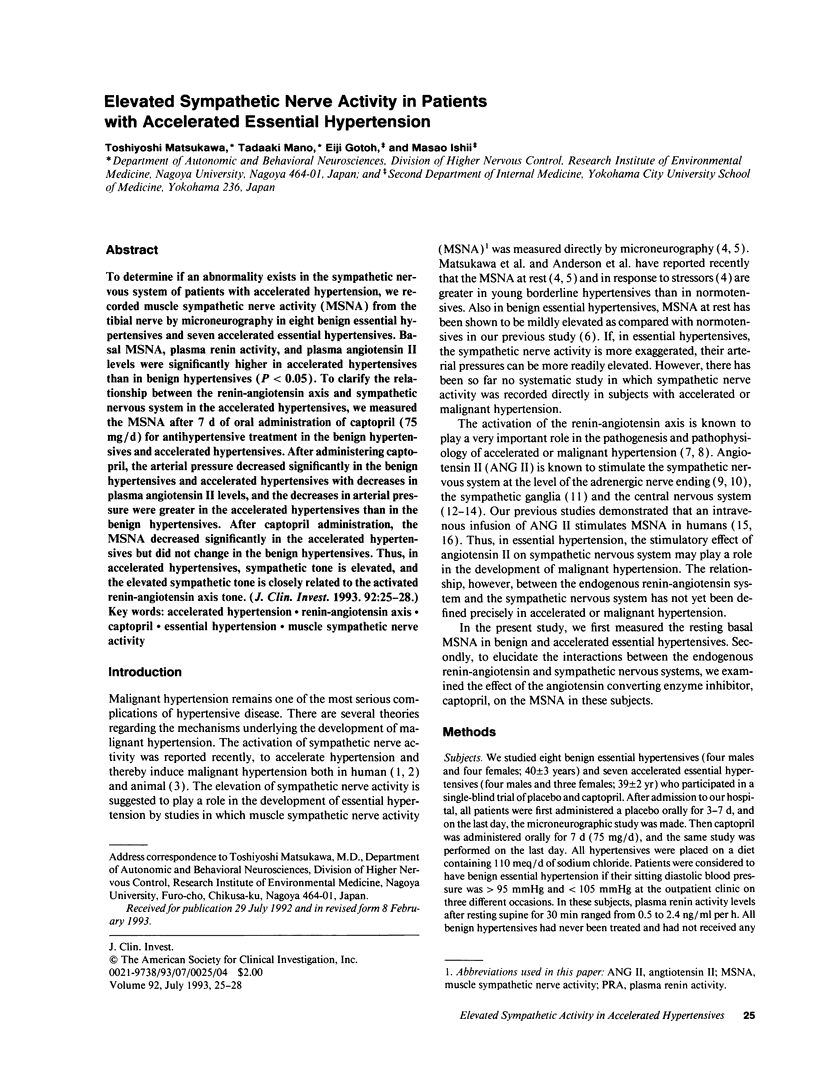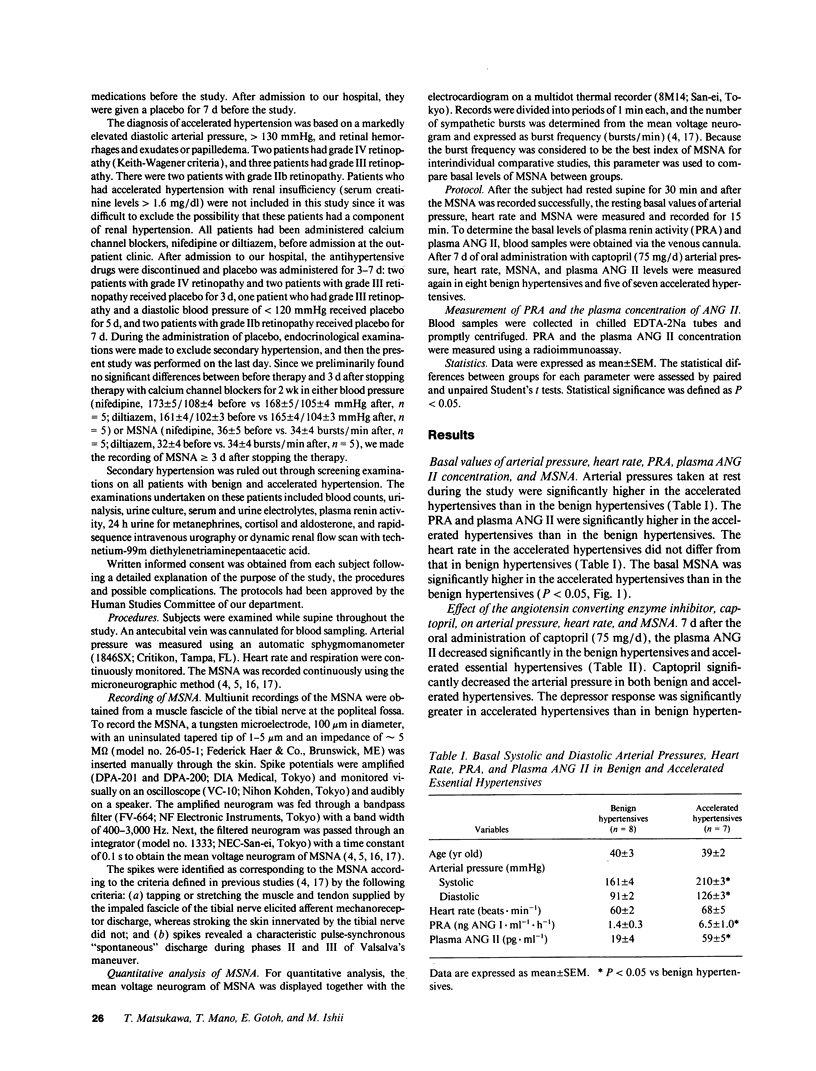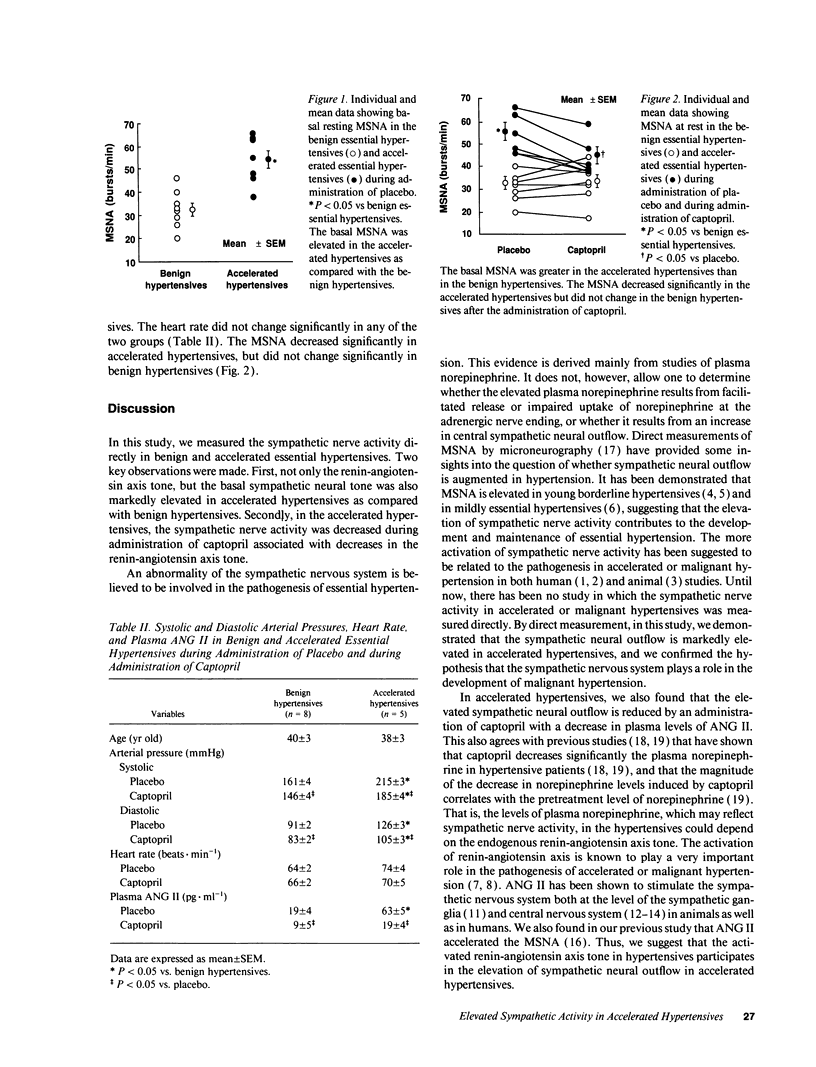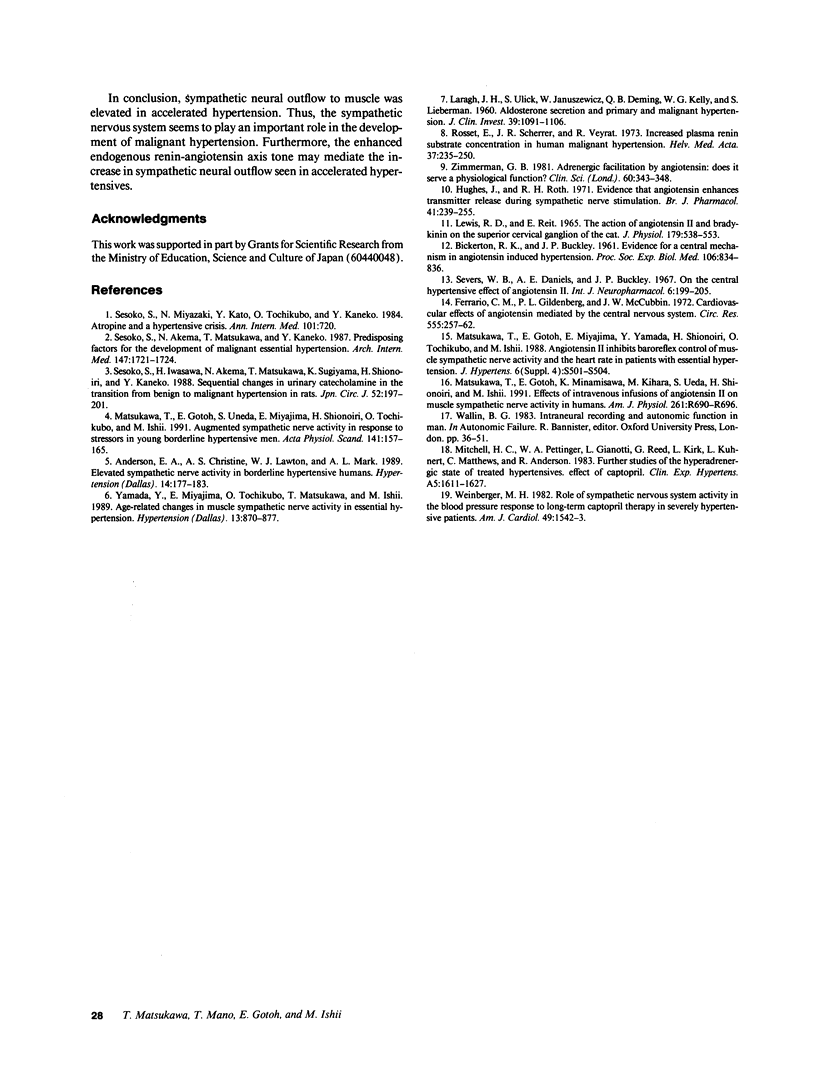Abstract
To determine if an abnormality exists in the sympathetic nervous system of patients with accelerated hypertension, we recorded muscle sympathetic nerve activity (MSNA) from the tibial nerve by microneurography in eight benign essential hypertensives and seven accelerated essential hypertensives. Basal MSNA, plasma renin activity, and plasma angiotensin II levels were significantly higher in accelerated hypertensives than in benign hypertensives (P < 0.05). To clarify the relationship between the renin-angiotensin axis and sympathetic nervous system in the accelerated hypertensives, we measured the MSNA after 7 d of oral administration of captopril (75 mg/d) for antihypertensive treatment in the benign hypertensives and accelerated hypertensives. After administering captopril, the arterial pressure decreased significantly in the benign hypertensives and accelerated hypertensives with decreases in plasma angiotensin II levels, and the decreases in arterial pressure were greater in the accelerated hypertensive than in the benign hypertensives. After captopril administration, the MSNA decreased significantly in the accelerated hypertensives but did not change in the benign hypertensives. Thus, in accelerated hypertensives, sympathetic tone is elevated, and the elevated sympathetic tone is closely related to the activated renin-angiotensin axis tone.
Full text
PDF



Selected References
These references are in PubMed. This may not be the complete list of references from this article.
- Anderson E. A., Sinkey C. A., Lawton W. J., Mark A. L. Elevated sympathetic nerve activity in borderline hypertensive humans. Evidence from direct intraneural recordings. Hypertension. 1989 Aug;14(2):177–183. doi: 10.1161/01.hyp.14.2.177. [DOI] [PubMed] [Google Scholar]
- Ferrario C. M., Gildenberg P. L., McCubbin J. W. Cardiovascular effects of angiotensin mediated by the central nervous system. Circ Res. 1972 Mar;30(3):257–262. doi: 10.1161/01.res.30.3.257. [DOI] [PubMed] [Google Scholar]
- Hughes J., Roth R. H. Evidence that angiotensin enhances transmitter release during sympathetic nerve stimulation. Br J Pharmacol. 1971 Feb;41(2):239–255. doi: 10.1111/j.1476-5381.1971.tb08025.x. [DOI] [PMC free article] [PubMed] [Google Scholar]
- LARAGH J. H., ULICK S., JANUSZEWICZ V., DEMING Q. B., KELLY W. G., LIEBERMAN S. Aldosterone secretion and primary and malignant hypertension. J Clin Invest. 1960 Jul;39:1091–1106. doi: 10.1172/JCI104124. [DOI] [PMC free article] [PubMed] [Google Scholar]
- Lewis G. P., Reit E. The action of angiotensin and bradykinin on the superior cervical ganglion of the cat. J Physiol. 1965 Aug;179(3):538–553. doi: 10.1113/jphysiol.1965.sp007679. [DOI] [PMC free article] [PubMed] [Google Scholar]
- Matsukawa T., Gotoh E., Minamisawa K., Kihara M., Ueda S., Shionoiri H., Ishii M. Effects of intravenous infusions of angiotensin II on muscle sympathetic nerve activity in humans. Am J Physiol. 1991 Sep;261(3 Pt 2):R690–R696. doi: 10.1152/ajpregu.1991.261.3.R690. [DOI] [PubMed] [Google Scholar]
- Matsukawa T., Gotoh E., Miyajima E., Yamada Y., Shionoiri H., Tochikubo O., Ishii M. Angiotensin II inhibits baroreflex control of muscle sympathetic nerve activity and the heart rate in patients with essential hypertension. J Hypertens Suppl. 1988 Dec;6(4):S501–S504. doi: 10.1097/00004872-198812040-00158. [DOI] [PubMed] [Google Scholar]
- Matsukawa T., Gotoh E., Uneda S., Miyajima E., Shionoiri H., Tochikubo O., Ishii M. Augmented sympathetic nerve activity in response to stressors in young borderline hypertensive men. Acta Physiol Scand. 1991 Feb;141(2):157–165. doi: 10.1111/j.1748-1716.1991.tb09064.x. [DOI] [PubMed] [Google Scholar]
- Mitchell H. C., Pettinger W. A., Gianotti L., Reed G., Kirk L., Kuhnert L., Matthews C., Anderson R. Further studies on the hypernoradrenergic state of treated hypertensives: effect of captopril. Clin Exp Hypertens A. 1983;5(10):1611–1627. doi: 10.3109/10641968309051798. [DOI] [PubMed] [Google Scholar]
- Rosset E., Scherrer J. R., Veyrat R. Increased plasma renin substrate concentration in human malignant hypertension. Helv Med Acta. 1973 Oct;37(4):235–250. [PubMed] [Google Scholar]
- Sesoko S., Akema N., Matsukawa T., Kaneko Y. Predisposing factors for the development of malignant essential hypertension. Arch Intern Med. 1987 Oct;147(10):1721–1724. [PubMed] [Google Scholar]
- Sesoko S., Iwasawa H., Akema N., Matsukawa T., Sugiyama K., Shionoiri H., Kaneko Y. Sequential changes in urinary catecholamine in the transition from benign to malignant hypertension in rats. Jpn Circ J. 1988 Feb;52(2):197–202. doi: 10.1253/jcj.52.197. [DOI] [PubMed] [Google Scholar]
- Sesoko S., Miyazaki N., Kato Y., Tochikubo O., Kaneko Y. Atropine and a hypertensive crisis. Ann Intern Med. 1984 Nov;101(5):720–720. doi: 10.7326/0003-4819-101-5-720_1. [DOI] [PubMed] [Google Scholar]
- Severs W. B., Daniels A. E., Buckley J. P. On the central hypertensive effect of angiotensin II. Int J Neuropharmacol. 1967 May;6(3):199–205. doi: 10.1016/0028-3908(67)90006-8. [DOI] [PubMed] [Google Scholar]
- Weinberger M. H. Role of sympathetic nervous system activity in the blood pressure response to long-term captopril therapy in severely hypertensive patients. Am J Cardiol. 1982 Apr 21;49(6):1542–1543. doi: 10.1016/0002-9149(82)90383-6. [DOI] [PubMed] [Google Scholar]
- Yamada Y., Miyajima E., Tochikubo O., Matsukawa T., Ishii M. Age-related changes in muscle sympathetic nerve activity in essential hypertension. Hypertension. 1989 Jun;13(6 Pt 2):870–877. doi: 10.1161/01.hyp.13.6.870. [DOI] [PubMed] [Google Scholar]
- Zimmerman B. G. Adrenergic facilitation by angiotensin: does it serve a physiological function? Clin Sci (Lond) 1981 Apr;60(4):343–348. doi: 10.1042/cs0600343. [DOI] [PubMed] [Google Scholar]


